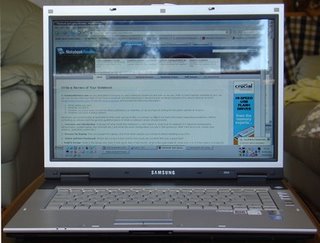
The Systemax Epic is a widescreen, thin-and-light notebook. The system as reviewed is priced at $1,799, and is configured as follows:
* PROCESSOR: Intel Core Duo T2500 (2.0GHz)
* CHIPSET: Intel 945GM
* MEMORY: 2GB DDR2-533 PC4200 (two DIMMs, no slots free)
* HARD DISK: 100GB 5400rpm SATA
* OPTICAL DRIVE: DVD+/-RW
* SCREEN: 13" WXGA (1280x768) Glossy
* VIDEO: Intel Graphics Media Accelerator 950
* AUDIO: RealTek Hi-Definition Audio
* WIRELESS: Intel PRO/Wireless 3945ABG
* WIRED: 56K V.92 Modem, Gigabit Ethernet
* PORTS: 3x USB 2.0, 1x FireWire (4-pin), Audio Out, Microphone Jack, VGA, S-Video, Type I/II PCMCIA, Media Reader (supports Secure Digital card, Memory Stick, Memory Stick PRO, Multi-Media Card), RJ-11 Modem Jack, RJ-45 Ethernet Jack
* OPERATING SYSTEM: Microsoft Windows XP Professional
* MISC.: Built-in Microphone, Microsoft Office 2003 Professional
* DIMENSIONS: 12.4" Wide, 1.4" High, 8.8" Deep, 4.75 lbs.
* WARRANTY: Warranted to Systemax, 12 months parts and labor
This is a prefab model offered from Tigerdirect.com; a custom configured one starts as low as $999.
While you may not have heard of Systemax, they've actually been around for some time, serving primarily the business sector. As a result, availability of their products isn't wholly widespread, but they do have a reputation. I work in tech support for the county, and one of my fellow technicians had a lot of good things to say about the brand.
Systemax offers a variety of hardware suited to different professional tasks and tastes, and they pride themselves on being a die hard American company. Their notebooks are assembled here, and their tech support is handled by American workers. Not having to worry about trying to decipher a foreign accent when you call for help is a major convenience.
This particular notebook is designed for the mobile professional and NOT for the gamer. As a result, this review will focus primarily on its suitability for those tasks against the competition.
BUILD AND DESIGN
The build quality of the Epic is fairly solid. While the shell is plastic, it's a hard, smooth plastic. I'm not sure it's all that great for repeatedly slamming against a wall and I don't think it would make a very good shoe, it certainly feels very durable.
t's clear from the outset, however, that it wasn't designed for looks. It's not much of a head turner, with the rote black and silver styling that's become all the rage of virtually every notebook on the market. Additionally, while the unit features smooth curves, it's honestly not very appealing looking, and the keyboard in particular has a very plain print on the keys.























